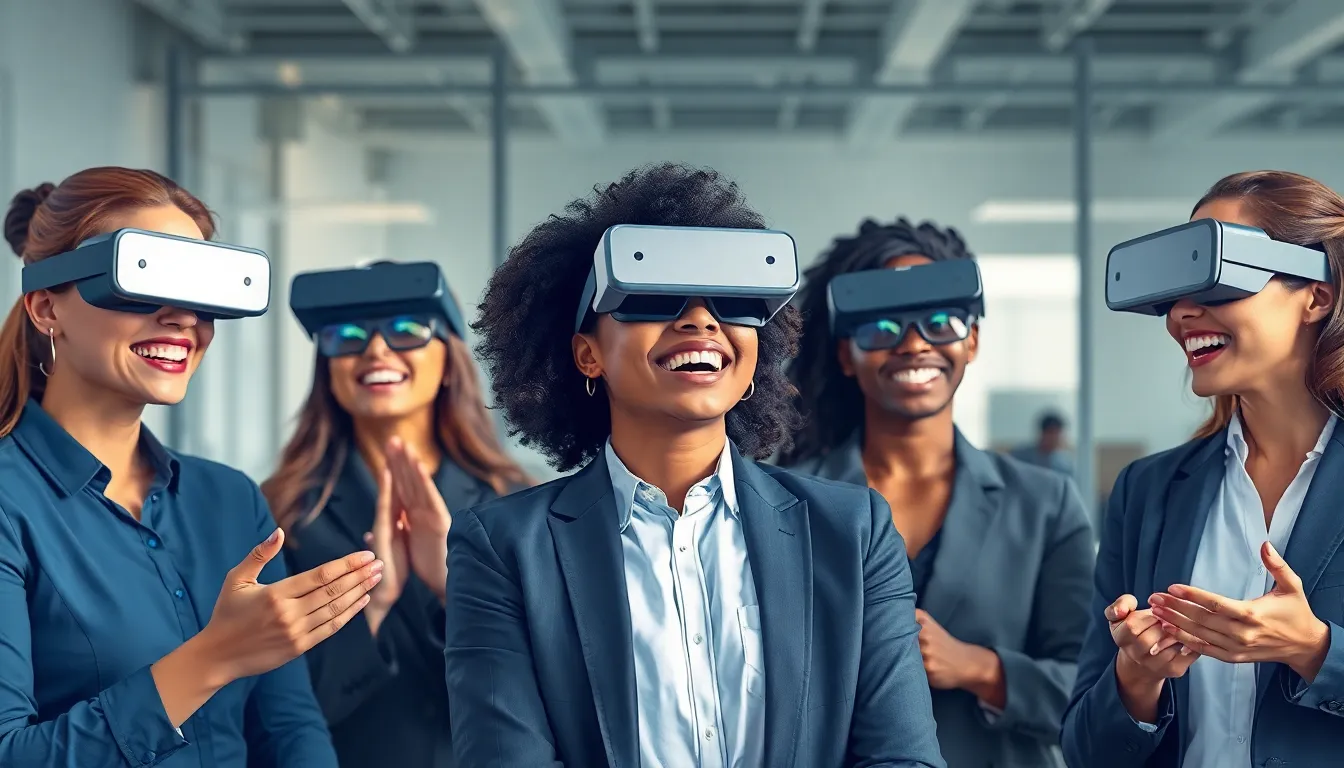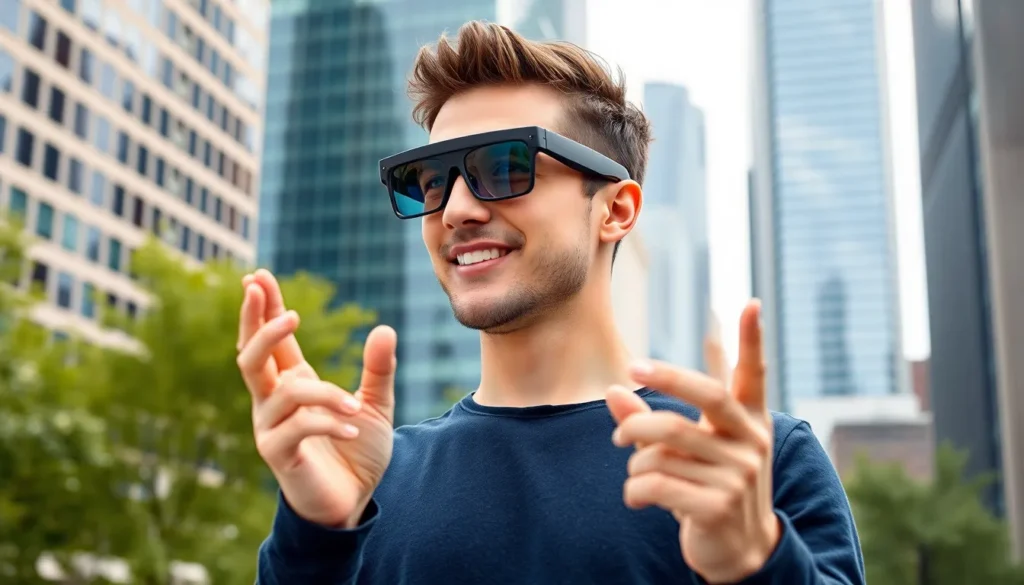Imagine a world where your glasses do more than just help you see; they transform reality itself. Welcome to the booming AR and VR smart glasses market, where the line between the digital and physical blurs faster than you can say “virtual reality.” These sleek gadgets aren’t just for tech enthusiasts anymore—they’re becoming essential tools for everyone from gamers to professionals.
As the market evolves, it’s hard not to get excited about the possibilities. Whether it’s enhancing your gaming experience or revolutionizing how businesses train employees, smart glasses are the new frontier. With innovations popping up faster than a magician’s rabbit, it’s clear this tech is here to stay. Buckle up as we dive into the trends, challenges, and future of this fascinating market.
ar and vr smart glasses market
The AR and VR smart glasses market experiences significant growth due to rising consumer interest. As of 2023, the market is projected to reach $9 billion, driven by advancements in technology and content availability. This growth attracts investment across various sectors, including entertainment, healthcare, and education.
Industrial applications lead market demand with training simulations. Companies utilize AR and VR to enhance employee skills and improve safety protocols. Real-time data overlays become increasingly essential in manufacturing, allowing workers to access critical information hands-free.
Gaming forms another cornerstone of this market. Gamers value immersive experiences, leading to increased sales of AR and VR devices. The introduction of popular titles further stimulates demand, sparking competition among developers.
Smart glasses offer unique opportunities for professionals too. Architects utilize AR to visualize projects, facilitating better collaboration with clients. Medical professionals embrace VR for surgical simulations, enhancing learning experiences without risk.
Consumer adoption remains a key focus. Pricing strategies impact accessibility, with manufacturers exploring options to bring costs down. A growing range of use cases and improved user interfaces fuel interest among everyday users.
Key players such as Microsoft and Google dominate the landscape. These companies continue to innovate, driving advancements in functionality and design. Emerging startups also contribute, pushing the boundaries of what AR and VR can achieve.
Overall, the AR and VR smart glasses market displays promising potential. Innovations transform user interactions across various fields, indicating a bright future for these groundbreaking technologies.
Key Players in the Market

The AR and VR smart glasses market features a dynamic mix of established companies and innovative startups driving advancements. Major players influence the industry with cutting-edge technology and strategic partnerships.
Major Manufacturers
Microsoft stands out with its HoloLens, tailored for enterprise applications across various sectors. Google continues to innovate with its Glass Enterprise Edition, aimed at enhancing productivity in the workplace. Facebook’s parent company Meta invests heavily in developing VR technologies, primarily through its Quest series. Sony captivates gamers with its PlayStation VR, creating immersive experiences. Apple enters the scene with rumored AR glasses, generating significant anticipation. Each of these manufacturers plays a critical role in shaping market trends and consumer expectations.
Emerging Startups
Numerous startups are redefining the AR and VR landscape. Magic Leap focuses on mixed reality solutions with its Magic Leap 2, designed for enterprises. Snap, known for its Snapchat app, pushes boundaries through AR spectacles that engage users daily. Varjo creates professional-grade VR headsets, offering high fidelity for training and simulation. Nreal targets consumers with lightweight AR glasses that enhance mobile experiences. These emerging players contribute to increased competition and innovation, ensuring the market evolves rapidly.
Current Trends Shaping the Market
The AR and VR smart glasses market evolves rapidly, influenced by various trends shaping its trajectory.
Technological Advancements
Innovative technologies drive the development of AR and VR smart glasses. Enhanced display resolutions, wider field of view, and more natural user interfaces improve user experiences. Companies invest in miniaturization, making devices lighter and more comfortable. Artificial intelligence integration enhances interactivity and personalization. Moreover, 5G connectivity enables seamless data transmission, supporting more immersive applications. Research continues into augmented reality overlays for real-world environments. As a result, industrial sectors eagerly adopt these advanced technologies for efficiency and productivity gains.
Consumer Adoption Rates
Consumer adoption rates for AR and VR smart glasses increase steadily. Estimates project the consumer market reaching $4 billion by the end of 2023. Gamers, tech enthusiasts, and early adopters fuel this growth. Also, educational institutions utilize these devices for new learning experiences, promoting engagement and retention. Manufacturers focus on pricing strategies, ensuring more affordability and accessibility. Popularity grows as more applications become available, catering to interests beyond gaming. Lastly, social media content and influencer promotions contribute to heightened consumer awareness and usage, creating a broader audience for these technologies.
Challenges Facing the AR and VR Smart Glasses Market
The AR and VR smart glasses market faces several significant challenges that may hinder growth. Addressing these issues proves crucial for sustained development.
High Production Costs
High production costs create barriers for manufacturers in the AR and VR smart glasses market. Complex technology components often contribute to elevated prices, affecting affordability for consumers. Companies must invest in research and development to optimize production processes, ultimately relying on economies of scale to reduce costs. Smaller manufacturers encounter difficulties competing against established players, as they may lack the resources needed for cost-effective production. Without innovative strategies, long-term profit margins will remain under pressure.
Privacy Concerns
Privacy concerns pose a considerable challenge for the adoption of AR and VR smart glasses. Consumers worry about the potential for unauthorized data collection and surveillance, creating reluctance to embrace these devices. Incidents involving misuse of technology heighten user fears, impacting brand trust among potential buyers. Companies must prioritize transparency and implement robust data protection policies to alleviate these concerns. Enhanced security measures can help restore consumer confidence, ensuring that users feel safe while utilizing smart glasses in various settings.
Future Predictions for the Market
The AR and VR smart glasses market is positioned for significant advancement. Projections indicate a reach of $9 billion by the end of 2023, driven by technological innovations and rising consumer interest.
Growth Opportunities
Major growth opportunities exist in sectors like healthcare and education. Medical professionals use AR and VR for surgical training and patient simulations. Schools adopt these technologies for interactive learning experiences, enhancing student engagement. Companies see immense potential in sectors like retail, where virtual try-ons improve shopping experiences. Additionally, the rise of remote work creates demand for collaboration tools, facilitated by AR and VR. Manufacturers face pressure to create affordable solutions, which will accelerate market growth.
Potential Market Segments
Diverse segments within the AR and VR smart glasses market show promise. The gaming industry continues to expand, with immersive experiences driving user engagement. Enterprise solutions also attract attention, as businesses seek to enhance productivity through training simulations. Healthcare stands out, as professionals rely on visualization tools for complex procedures. Consumer entertainment, such as AR-enabled spectacles, captures interest among tech enthusiasts. Lastly, niche markets like architecture and design benefit from enhanced visualization capabilities, further driving innovation.
Conclusion
The AR and VR smart glasses market stands on the brink of transformation. With advancements in technology and increasing consumer interest it’s set to redefine how individuals interact with their environments. From enhancing gaming experiences to revolutionizing professional training the potential applications are vast and varied.
Major players and innovative startups are driving competition and pushing boundaries ensuring continuous evolution in this space. As manufacturers focus on affordability and accessibility the barriers to entry are gradually lowering. However addressing privacy concerns will be crucial for maintaining consumer trust.
Overall the future looks bright for AR and VR smart glasses as they promise to enhance daily life across multiple sectors. The ongoing developments in this market will undoubtedly shape the way people engage with technology in the years to come.



![[author] arkit and unity: build a drivable car in augmented reality course](https://wzhi58.com/wp-content/uploads/2024/11/1b145239-102d-43d9-8674-80113a75e375_hGjkhjyx0SxSyWk99mwY3-1024x585.jpeg)